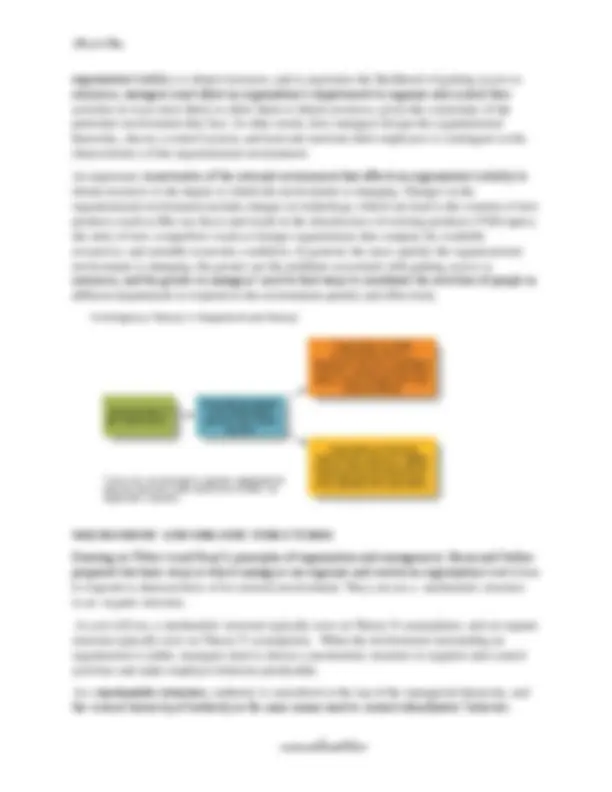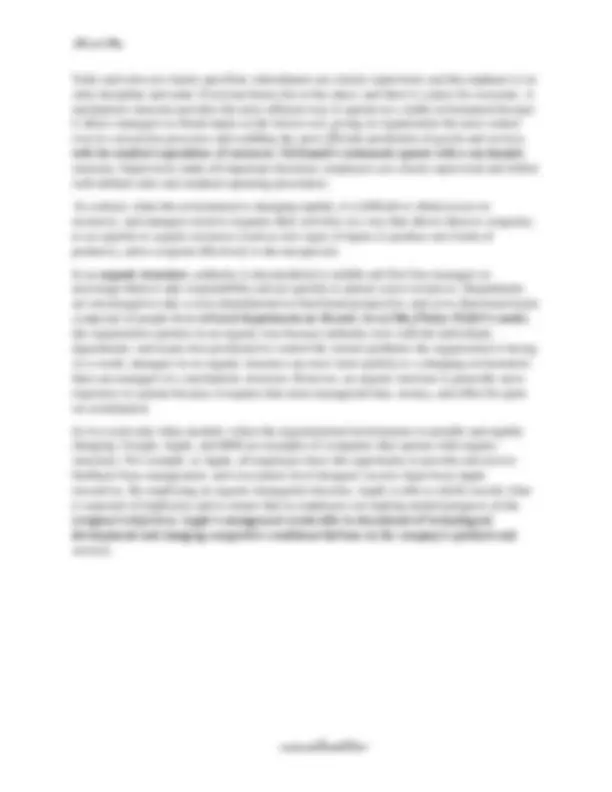




Study with the several resources on Docsity

Earn points by helping other students or get them with a premium plan


Prepare for your exams
Study with the several resources on Docsity

Earn points to download
Earn points by helping other students or get them with a premium plan
Community
Ask the community for help and clear up your study doubts
Discover the best universities in your country according to Docsity users
Free resources
Download our free guides on studying techniques, anxiety management strategies, and thesis advice from Docsity tutors
An insightful exploration of organizational environment theory, focusing on the open-systems view and contingency theory. The open-systems view, developed by katz, kahn, and thompson, explains how organizations acquire resources, convert them into goods and services, and release them back to the environment for further acquisition. Contingency theory, developed by burns, stalker, lawrence, and lorsch, emphasizes that there is no one-size-fits-all approach to organizing and managing an organization, as the organizational structures and control systems depend on the characteristics of the external environment. The document also discusses the importance of understanding the relationship between an organization and its environment to maximize resource acquisition and organizational effectiveness.
Typology: Lecture notes
1 / 4

This page cannot be seen from the preview
Don't miss anything!



An important milestone in the history of management thought occurred when researchers went beyond the study of how managers can influence behavior within organizations to consider how managers control the organization’s relationship with its external environment, or organizational environment —the set of forces and conditions that operate beyond an organization’s boundaries but affect a manager’s ability to acquire and utilize resources.
Resources in the organizational environment include the raw materials and skilled people that an organization requires to produce goods and services, as well as the support of groups, including customers who buy these goods and services and provide the organization with financial resources. One way of determining the relative success of an organization is to consider how effective its managers are at obtaining scarce and valuable resources. The importance of studying the environment became clear after the development of open-systems theory and contingency theory during the 1960s.
The Open-Systems View
One of the most influential views of how an organization is affected by its external environment was developed by Daniel Katz, Robert Kahn, and James Thompson in the 1960s. These theorists viewed the organization as an open system —a system that takes in resources from its external environment and converts or transforms them into goods and services that are sent back to that environment, where they are bought by customers.
At the input stage an organization acquires resources such as raw materials, money, and skilled workers to produce goods and services. Once the organization has gathered the necessary resources, conversion begins.
At the conversion stage the organization’s workforce, using appropriate tools, techniques, and machinery, transforms the inputs into outputs of finished goods and services such as cars, hamburgers, or flights to Hawaii.
At the output stage the organization releases finished goods and services to its external environment, where customers purchase and use them to satisfy their needs. The money the organization obtains from the sales of its outputs allows the organization to acquire more resources so the cycle can begin again.
The system just described is said to be open because the organization draws from and interacts with the external environment in order to survive; in other words, the organization is open to its environment. A closed system, in contrast, is a self-contained system that is not affected by changes in its external environment. Organizations that operate as closed systems, that ignore the external environment, and that fail to acquire inputs are likely to experience entropy, which is the tendency of a closed system to lose its ability to control itself and thus to dissolve and disintegrate.
Management theorists can model the activities of most organizations by using the open- systems view. Manufacturing companies like Ford and General Electric, for example, buy inputs such as component parts, skilled and semiskilled labor, and robots and computer- controlled manufacturing equipment; then at the conversion stage they use their manufacturing skills to assemble inputs into outputs of cars and appliances. As we discuss in later chapters, competition between organizations for resources is one of several major challenges to managing the organizational environment.
Researchers using the open-systems view are also interested in how the various parts of a system work together to promote efficiency and effectiveness. Systems theorists like to argue that the whole is greater than the sum of its parts; they mean that an organization performs at a higher level when its departments work together rather than separately. Synergy , the performance gains that result from the combined actions of individuals and departments, is possible only in an organized system. The recent interest in using teams combined or composed of people from different departments reflects systems theorists’ interest in designing organizational systems to create synergy and thus increase efficiency and effectiveness.
The Contingency Theory
Another milestone in management theory was the development of contingency theory in the 1960s by Tom Burns and G. M. Stalker in Britain and Paul Lawrence and Jay Lorsch in the United States. The crucial message of contingency theory is that there is no one best way to organize: The organizational structures and the control systems that managers choose depend on (are contingent on) characteristics of the external environment in which the organization operates. According to contingency theory, the characteristics of the environment affect an
Tasks and roles are clearly specified, subordinates are closely supervised, and the emphasis is on strict discipline and order. Everyone knows his or her place, and there is a place for everyone. A mechanistic structure provides the most efficient way to operate in a stable environment because it allows managers to obtain inputs at the lowest cost, giving an organization the most control over its conversion processes and enabling the most efficient production of goods and services with the smallest expenditure of resources. McDonald’s restaurants operate with a mechanistic structure. Supervisors make all important decisions; employees are closely supervised and follow well-defined rules and standard operating procedures.
In contrast, when the environment is changing rapidly, it is difficult to obtain access to resources, and managers need to organize their activities in a way that allows them to cooperate, to act quickly to acquire resources (such as new types of inputs to produce new kinds of products), and to respond effectively to the unexpected.
In an organic structure ,authority is decentralized to middle and first-line managers to encourage them to take responsibility and act quickly to pursue scarce resources. Departments are encouraged to take a cross departmental or functional perspective, and cross-functional teams composed of people from different departments are formed. As in Mary Parker Follett’s model, the organization operates in an organic way because authority rests with the individuals, departments, and teams best positioned to control the current problems the organization is facing. As a result, managers in an organic structure can react more quickly to a changing environment than can managers in a mechanistic structure. However, an organic structure is generally more expensive to operate because it requires that more managerial time, money, and effort be spent on coordination.
So it is used only when needed—when the organizational environment is unstable and rapidly changing. Google, Apple, and IBM are examples of companies that operate with organic structures. For example, at Apple, all employees have the opportunity to provide and receive feedback from management, and even junior-level designers receive input from Apple executives. By employing an organic managerial structure, Apple is able to clarify exactly what is expected of employees and to ensure that its employees are making needed progress on the company’s objectives. Apple’s management is also able to stay abreast of technological developments and changing competitive conditions that bear on the company’s products and services